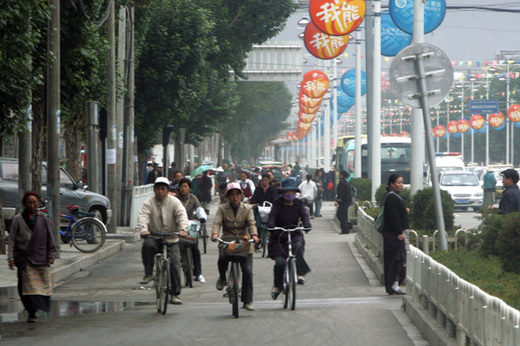Posted on : Sep.30,2006 14:27 KST
Modified on : Oct.2,2006 14:42 KST
 |
|
Downtown Lhasa
|
According to the Tibetan calendar, New Year’s Day falls on the 28th of February. This year, it fell about one month after Chinese New Year’s Day (January 29th). On the holiday, Tibetans dress up in their finest clothes and go to their local temple. The clothing style of choice used to be shirts and pants lined with the fur of the seal otter, as well as a leopard skin draped across the back. This year, however, the number of Tibetans donning this attire had visibly declined. One official at the Tibetan local autonomous government went so far as to say "there was hardly a visible presence of people wearing animal skins." Why did such a change take place so suddenly?
A Tibetan I met in front of Lhasa’s Jokhang Monastry said it was "an appeal from the Dalai Lama." Living in exile in India since 1959, the Dalai Lama implored his compatriots in a gathering before New Year’s Day not to wear clothing made from animal skins. "Someone kills a living thing for every piece of clothing made from animal skin that you wear," he said.
A question lingered: With China maintaining strict regulation over the media, how could the Tibetans have heard the Dalai Lama’s appeal? The answer was word of mouth, on a large scale. Some 4,000 Tibetans had gained a visa from the Chinese government at the end of last year and had visited India, where they attended the Dalai Lama’s gathering, and it is whispered that another 4,000 secretly crossed the border to attend the meeting, as well. Upon their return, they spread the Dalai Lama’s message to their fellow Tibetans. It would seem that the Dalai Lama still exerts a spiritual influence upon Tibetans, despite his exile. But how significant is this influence?
Another youth I met in front of the Ramoche Monastry on September 16 expressed his plans to go to Dharamsala in India in December. "My mother’s hope was to see the Dalai Lama with her own eyes during her lifetime," he said. "But she is too old now, and her health is not good, so I will go in her place." In which case he may never set foot on Chinese land again. Even so, this is what his mother said to him: "If you see the Dalai Lama, it is fine if you never see me again. If you prepare meals for him, do his laundry or clean on his behalf, then you will have found the best job on Earth. That is something more precious than coming to see me, more valuable than gaining a Ph.D." The youth added about his mother’s words, "This is a common view among Tibetans."
The government in exile, lead by the Dalai Lama since 1959, has chosen to take a moderate stance against China, advocating a highly autonomous Tibet rather than independence, which could only come at the cost of a gory struggle. Hong Kong is understood to be the model for such an autonomy. In 2001, direct elections were held among Tibetans in exile, and Kalon Tripa Samdhong Rinpoche was chosen to lead the government, thus completing the Dalai Lama’s desired reform of separating politics and religion. The Dalai Lama is also promoting a change in the method of choosing his successor such that, rather than choosing a child reincarnate, the next Dalai Lama would be chosen through election.
However, negotiations between the Tibetan government in exile and the Chinese authorities have reached a deadlock. An official from the local government said that, "Tibet already has autonomy" and that "the Dalai Lama’s visit to China would be welcomed if he came as an individual, but not as the head of the government in exile."
A calm has been maintained in Tibet since the series of revolts and bloody crackdowns that shook Lhasa in 1989. This calm is in no small part due to the massive aid given the region by the Chinese government as well as the Dalai Lama’s emphasis on peace and nonviolence. The Hong Kong weekly Yazhou Zhoukan predicted that after the 71-year-old Dalai Lama passes away, the Tibetan Government in Exile is likely to embrace more extreme tactics to push for Tibetan independence. Although the authority of the Dalai Lama conceals them, there are many young monks in exile and groups such as the Tibetan Youth Association that call for "the mobilization of all means necessary to achieve Tibetan independence." The leader of the Tibetan Youth Association for the last four years does not hide his disagreement with the Dalai Lama, stating "the Tibetan Youth Association will use whatever means necessary for Tibet, and will support Tibet all the way if its independence is brought about through armed struggle." Transition in the region - and the future of Tibet - will be something to watch in the upcoming years.




